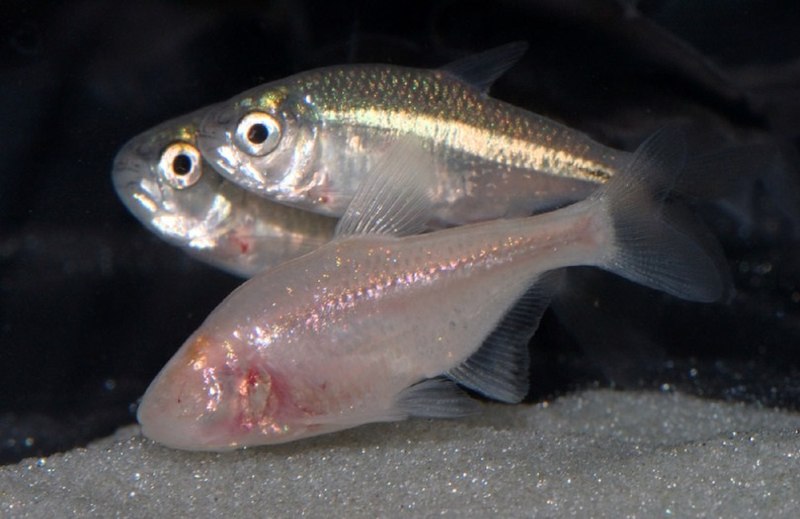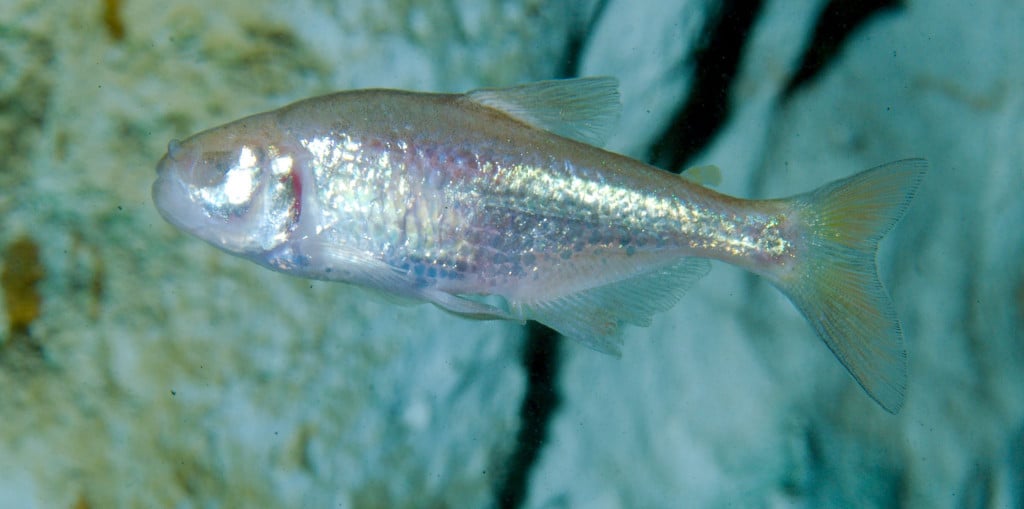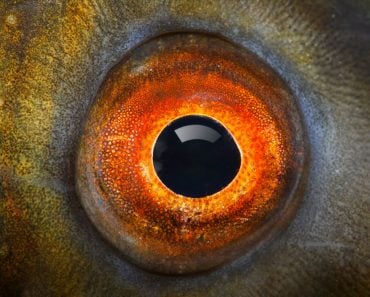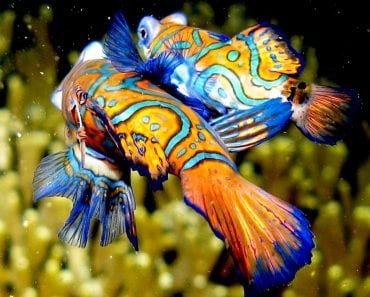Table of Contents (click to expand)
The Mexican tetra evolved the ability to live without sight when its surface-dwelling cousins shifted to living in dark limestone caves during the Pleistocene period.
Before we get into the science stuff behind this peculiar blind fish, allow me to tickle your funny bone. Here’s a joke for you.

Now, it’s not uncommon to come across a blind fish among a school of fish. There are some unfortunate individuals that are simply born without eyes.
However, are there any species where having no eyeballs is a part of their natural process of evolution?
Let me introduce you to Astyanax mexicanus, commonly known as the Mexican Blind Cavefish or the Blind Cave Tetra. They live in a perpetual state of darkness for the vast majority of their lifespan. Their eye degeneration is because the species did not pay any heed to the “use it or lose it” principle of evolution.
So why did the species undergo such drastic modification? And are they blind from birth?
Recommended Video for you:
The Mexican Blind Cavefish

The mere thought of going into a cave without a flashlight and navigating the pitch darkness can be unnerving. However, the Mexican tetra has evolved the ability to live without sight. During the Pleistocene period, the eyed, surface-dwelling (epigean) Astyanax fishes shifted to living in the limestone caves between central Mexico and south Texas. Over the years, their descendants evolved to lose their eyes and pigmentation, and have come to be known as the cave-dwelling (hypogean) Mexican tetra.

Therefore, a single species—Astyanax mexicanus—branched into two types: the surface-dwelling fish with both eyes and the cave-dwelling fish with no eyes. The Mexican cavefish is a teleost fish that belongs to the order Characiformes. They are troglodytes, meaning that they spend their lives in the darkness of caves in North Mexico.
Like most troglodytes, the characteristics of Mexican cavefish include blindness, loss of pigmentation, enhanced tactile & chemical senses, advanced food-finding ability, reduced energy needs, attraction to vibrations, shorter lifespan, reduced genetic diversity and smaller population sizes.
Are Mexican Cavefish Born Without Eyes?
Mexican cavefish follow a similar path of eye formation as their surface-living relatives A. mexicanus. The cavefish forms a small rudimentary eye for the first 24 hours of embryonic development, but soon after, the eye development arrests and starts the process of regressive changes, such as eye degeneration and loss of pigmentation.

The first sign of degeneration is marked by the apoptosis (cell death) of the lens, followed by retinal degeneration. Ultimately, the eyes sink into orbit and the non-pigmented scales cover the eye, just like the rest of the body.
What Causes Blindness?
The blindness in the Mexican tetra is caused by a few gene mutations, also referred to as the ‘master switches’. For Mexican cavefish, there is a master switch that controls eye development. The switch can disable the eye gene, rendering it useless. And this master switch in the cavefish is… shh.
No, it’s not a secret… ‘shh’ refers to the sonic hedgehog molecule (Shh). “Sonic hedgehog” is a signaling molecule, not the cartoon character.

Shh is a powerful morphogen that controls the fate of cells in a developing brain. It is responsible not only for modifications in eye development, but also for the forebrain of the cavefish.
During early embryogenesis, the shh signals from the anterior midline of the neural plate decide the level of certain genes (Pax6, Pax2 and Vax1). These genes play a critical role in tissue and organ formation during embryogenesis. Increased shh signaling leads to degeneration of the eyes, while a lack of shh signals leads to the formation of slightly larger eyes.
In the case of cavefish, an increase in levels of shh signaling is observed. This causes an imbalance between the Pax6, Pax2 and Vax1 levels. (Source). These genes are responsible for determining the gap between the two eyes and the size of the optic cups. This imbalance results in the formation of smaller optic cups and longer optic stalks. The over-expression of shh signals causes apoptosis of the lens and stops eye development.

However, the extent of cellular and molecular mechanisms involved in this mutation is not yet completely understood.
Why Does This Mutation Occur?
All organisms have undergone and are still undergoing the evolutionary process. Some lose an ancestral characteristic to adapt to their changing environment. The loss of the human tailbone is one such classic example. Similarly, the cavefish lost its eyes and pigmentation due to the evolution of the species. Though the one true explanation behind this mutation is not yet determined, there are currently three theories for regressive changes in the cavefish.
- Direct natural selection: This theory provides a simple explanation for the loss of the eye in the Mexican tetra. Since the habitat of the fish is a dark cave, the eye provides no visual advantage to the species. Instead, the absence of eyes helps them conserve their energy, as the food source is scarce in the caves. Maintaining the eye tissues and the optic nerves requires high amounts of metabolic energy.
- Indirect Selection: This employs the phenomenon of pleiotropy, where a single gene mutation affects more than one trait. The Shh signaling in cavefish negatively affects the eye, but also has positive effects on the development of taste buds. An increase in the number of taste buds allows the fish to find food more effectively. Thus, the species had to trade vision for more taste buds!
- Genetic Drift: This hypothesis suggests that natural selection had no role in the mutation seen in the Mexican tetra. Rather, the genetic mutation happened due to random events.
However, none of these theories have been definitively proven yet.
Conclusion
In a bargain with evolution, it appears that the cavefish bartered their eyes for other senses that give them a better chance of survival in the dark caves of Mexico. They gained extra taste buds that help them find food more quickly in the darkness of caves. Additionally, they have evolved a better mechano-sensory system, allowing them to perceive their environment by sensing vibrations.
All in all, being blind proved to be a major advantage to the cave-dwelling species of Astyanax Mexicanus!
References (click to expand)
- Rétaux, S., Pottin, K., & Alunni, A. (2008, March). Shh and forebrain evolution in the blind cavefish Astyanax mexicanus. Biology of the Cell. Wiley.
- Smith, M. U. (2017, February 1). How Does Evolution Explain Blindness in Cavefish?. The American Biology Teacher. University of California Press.
- Yamamoto, Y. (2004, November). Cavefish. Current Biology. Elsevier BV.
- . (2016). Biology and Evolution of the Mexican Cavefish. []. Elsevier.
- Krishnan, J., & Rohner, N. (2017, February 5). Cavefish and the basis for eye loss. Philosophical Transactions of the Royal Society B: Biological Sciences. The Royal Society.
- Tian, N. M. M.-L., & Price, D. J. (2005). Why cavefish are blind. BioEssays. Wiley.
- Why Do Cave Fish Lose Their Eyes?. The American Museum of Natural History
- Jeffery, W. R. (2003, August 1). To See or Not to See: Evolution of Eye Degeneration in Mexican Blind Cavefish. Integrative and Comparative Biology. Oxford University Press (OUP).
- Jeffery, W. R. (2001, March). Cavefish as a Model System in Evolutionary Developmental Biology. Developmental Biology. Elsevier BV.
- JEFFERY, W. R., & MARTASIAN, D. P. (1998, September). Evolution of Eye Regression in the CavefishAstyanax: Apoptosis and thePax-6Gene. American Zoologist. Oxford University Press (OUP).












